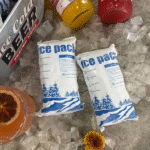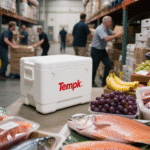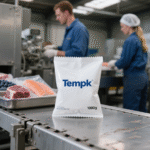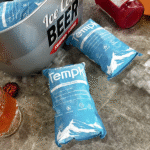Cold chain shipping containers are the backbone of today’s temperature controlled logistics. Ob Sie Impfstoffe transportieren, fresh seafood or plant based meat, maintaining the right environment ensures your goods arrive safe and effective. Modern containers use smart sensors, insulated walls and energy efficient refrigeration to maintain temperatures from –150 °C to +30 °C. In 2025 the installed base of remote tracking systems for refrigerated units is projected to grow from 2.7 million devices in 2023 Zu 4.5 Millionen von 2028, highlighting the rapid adoption of connected solutions. This guide explains why cold chain shipping containers matter, how they work and what trends you need to watch.

Why cold chain shipping containers are vital for product integrity.
How smart reefer containers and cryogenic shippers work, including their temperature ranges and typical uses.
Which innovations—like real time tracking, sustainable materials and automation—are shaping the industry in 2025.
What to consider when choosing a container and how to ensure compliance with regulations.
Frequently asked questions about cold chain containers and actionable tips for your business.
Why Are Cold Chain Shipping Containers Essential for Your Business?
Modern cold chain containers prevent spoilage and ensure regulatory compliance by maintaining strict temperature ranges during transit and storage. Perishable goods lose value quickly when exposed to temperature fluctuations; a single excursion can spoil pharmaceuticals or degrade the quality of fresh produce. Mehr als 85 % of biologics need cold storage, and consumer expectations for quality are rising. By using refrigerated containers with built in cooling units, businesses can protect fragile products and reduce waste.
Protecting Product Integrity: How Containers Maintain Temperature and Humidity
Reefer containers are specialized ISO containers fitted with active refrigeration units. They can maintain temperatures from –30 °C to +30 °C and sometimes include humidity control and remote monitoring. For pharmaceuticals and electronics, even minor temperature deviations can render products unusable. Many pharmaceutical shipments require temperatures between 2 °C und 8 °C (gekühlt) or below –20 °C (gefroren), while gene therapies often need cryogenic conditions of –150 °C or colder. Containers with precise thermostats and insulation help protect these sensitive items.
Zusätzlich, modern containers are equipped with sensors that measure humidity, shock and vibration in addition to temperature. LifeScience Logistics notes that IoT enabled systems can monitor temperature, humidity and shock to maintain product integrity and comply with traceability laws. By continuously recording these metrics, operators can intervene early if conditions drift, preventing spoilage and regulatory violations.
How Do Smart Reefer Containers Work?
Smart reefer containers combine refrigeration technology with IoT sensors and communication modules. They use compressors, condensers and evaporators to actively cool or heat the cargo space, while insulated walls minimize heat transfer. Temperature sensors inside the cargo area send data to a control unit, which adjusts cooling to maintain set points. The latest models offer remote monitoring via cellular or satellite networks. Zum Beispiel, Maersk has implemented a system that tracks the location and condition of around 380,000 refrigerated containers in real time. This connectivity allows operators to identify deviations quickly and reroute containers if needed.
Für ultrakalte Sendungen, cryogenic shippers rely on dry vapor liquid nitrogen (LN₂) Technologie. Dry vapor shippers can maintain –150 °C or lower for up to two weeks. They are essential for cell and gene therapy products because living cells and nucleic acids degrade quickly at higher temperatures. Cryoport’s HV3 shipping system is an example of a high volume cryogenic container that eliminates palletization and integrates condition monitoring. Unlike standard reefers that connect to a power source, cryogenic containers use vacuum insulation and absorbent material that holds vaporized LN₂, keeping the internal environment stable without liquid spillover.
| Containertyp | Temperaturbereich | Gemeinsame Verwendungen | Vorteile |
| Standard Reefer | –30 °C to +30 °C | Frische Produkte, Molkerei, Meeresfrüchte, Arzneimittel | Maintains chilled or frozen conditions; compatible with intermodal transport |
| Smart Reefer | –30 °C to +30 °C with remote monitoring | High value foods, Impfungen, Elektronik | Real time tracking of temperature, Luftfeuchtigkeit und Standort; reduces spoilage via alerts |
| Cryogenic Shipper | ≤ –150 °C | Zell- und Gentherapien, mRNA-Impfstoffe | Maintains ultra cold temperatures for up to 14 Tage; uses dry vapor LN₂ to avoid spillage |
| Portable Ultra Low Freezer | –80 °C to –60 °C | Biologische Proben, research reagents | Provides portable ultra low storage; often battery powered; complements cryogenic devices |
Practical Tips and Guidance
For delicate biologics: Choose cryogenic shippers or ultra low containers that maintain –150 °C to –60 °C. Ensure they include real time temperature sensors to track excursions.
For fresh foods or cosmetics: Standard or smart reefers that maintain 2 ° C bis 8 °C will suffice. Consider models with humidity control to prevent condensation damage.
Use insulated packaging inside containers: Boxes lined with phase change materials or vacuum insulated panels provide an extra buffer. Advanced materials like PCMs absorb or release heat to stabilize internal temperatures.
Real world Example: A biotech company used smart reefer containers equipped with GPS and temperature sensors to ship a gene therapy product overseas. Während des Transports, a delay at a port triggered an alarm when the container’s temperature began to rise. The company rerouted the container to a nearby cold storage facility, preventing a temperature excursion and saving the entire shipment. This intervention, enabled by real time data, avoided both product loss and costly regulatory consequences.
What Innovations Are Shaping Cold Chain Shipping Containers in 2025?
Die Kühlkettenbranche entwickelt sich rasant weiter. Emerging technologies like AI driven analytics, real time tracking and sustainable materials are transforming how containers are designed, operated and monitored. These innovations enhance visibility, reduce waste and improve energy efficiency.
Enhanced Distribution and Facility Modernization
Many companies are upgrading storage facilities to handle higher demand and stricter health standards. Older cold storage built 40–50 years ago can’t cope with current market volumes, so operators are modernizing buildings and expanding capacity. Investments in facility upscaling, automated storage and retrieval systems and robotic handling help move products faster while maintaining quality. This modernization ensures that temperature controlled goods aren’t stuck in outdated infrastructure.
New Products and Expanded Client Portfolios
The rise of plant based meat, lab grown proteins and specialty foods is increasing the diversity of temperature sensitive goods. Bloomberg projects the plant based food market to reach US$ 162 Milliarden von 2030, von US$ aufwärts 29.4 Milliarden in 2020. Many of these producers are small and have limited experience shipping globally. Cold chain providers must therefore adapt their services to cater to smaller clients and new product types, offering flexible container sizes and support for different temperature ranges.
Improved Visibility Through Smart Technology
Visibility is power—knowing the exact location and condition of your shipment allows you to prevent problems before they occur. In 2025, software and smart technologies enable businesses to monitor every aspect of their supply chain, from raw materials to final delivery. Investment in temperature monitoring and location tracking is increasing. Remote tracking systems shipments are expected to grow from 765,000 units in 2023 Zu 1.2 million units by 2028, while the installed base of active devices for cargo boxes and pallet shippers will rise from 2.2 Millionen bis 6.9 Million. This proliferation of sensors and data loggers makes supply chains more transparent and responsive.
Sustainability and Eco Friendly Designs
The cold chain industry is energy intensive and under pressure to reduce its environmental footprint. Refrigerated transport uses high GWP refrigerants and consumes significant energy. Um dies anzugehen, operators are phasing out synthetic refrigerants like HFCs and HCFCs. Sustainability also includes reusable packaging and renewable energy. Zum Beispiel, reusable shippers like Cold Chain Technologies’ EcoFlex cut fossil fuel use by 60 % and greenhouse gas emissions by 48 %, verhindern 80 million pounds of landfill waste. Solar powered reefer units and biodegradable insulation materials are becoming common, and consumers are willing to pay roughly 9.7 % more for sustainably produced goods.
Adoption of AI, Predictive Analytics and Robotics
Künstliche Intelligenz (Ai) and predictive analytics help forecast demand, predict temperature excursions and optimize routes. Automated systems like AS/RS (Automated Storage and Retrieval Systems) and autonomous mobile robots perform handling tasks accurately at temperatures as low as –25 °C. AI can analyze sensor data to identify anomalies, while predictive tools can adjust shipment schedules ahead of weather disruptions. Robotics reduces human exposure to cold environments, improving worker safety and efficiency.
Digital Transformation: Smart Containers and 5G Connectivity
Smart containers integrate IoT sensors, GPS and connectivity to transmit real time data on location, temperature and cargo condition. Fortune Business Insights notes that smart containers allow operators to increase container turn time and equipment availability. Partnerships like Sateliot and Sensefinity launched 5G IoT satellite connectivity that transmits data from 1,000 Smart Container, projected to save medium sized shipping companies up to US$ 1.4 million per year in repairs and maintenance. These technologies support predictive maintenance and reduce theft, spoilage and lawsuits.
Blockchain and Traceability
Blockchain provides an immutable record of temperature data and location events, enabling end to end traceability. Combining GS1 EPCIS event data with live sensor feeds ensures product authenticity and simplifies compliance documentation. This digital trail helps companies respond quickly to recalls and verify that temperature requirements were maintained throughout the journey.
| Innovation | Beschreibung | Ihr Vorteil |
| Ai & Prädiktive Analytik | AI analyzes real time data to forecast temperature excursions, optimize routes and schedule maintenance. | Helps anticipate issues and reduces delays, saving costs and product loss. |
| Wiederverwendbare Verpackung | Reusable shippers reduce single use waste and cut fossil fuel use by ~60 %. | Lowers environmental impact and can reduce long term logistics costs. |
| Smart Container Connectivity | IoT sensors and 5G satellite connectivity provide real time status on location and condition. | Enables proactive decision making and improves customer trust through transparency. |
| Cryogenic Infrastructure | Dry vapor LN₂ shippers maintain –150 °C or colder for two weeks. | Essential for gene therapies and mRNA vaccines; ensures viability during long transit. |
| Robotik & Automatisierung | AS/RS and AMR systems handle goods efficiently in cold environments. | Increases throughput, reduces labor costs and improves worker safety. |
Practical Tips for Leveraging Trends
Investieren Sie in intelligente Überwachung: Choose containers with built in IoT sensors and cloud connectivity. Remote alerts let you act before a shipment spoils.
Nehmen Sie nachhaltige Lösungen an: Evaluate reusable packaging and energy efficient refrigeration units. Explore solar or hybrid power systems for reefer trucks.
Leverage data: Use AI powered analytics to predict maintenance needs and optimize delivery routes. Analyze your sensor data to spot patterns like recurring hot spots or delays.
Upgrade facilities: Modernize cold storage with automated systems and consider robotics to reduce manual handling.
Fallbeispiel: A global dairy company reduced spoilage by 30 % after implementing real time temperature monitoring across its reefer fleet. The sensors alerted drivers to compressor malfunctions, enabling quick repairs and saving inventory. The company also switched to reusable containers, decreasing packaging waste and cutting logistic costs over time.
How to Select the Right Cold Chain Shipping Container for Your Needs
Choosing the right container involves balancing temperature requirements, Produktempfindlichkeit, Dauer, route complexity and sustainability goals. Here’s a step by step guide to help you make an informed choice.
Assess Your Product’s Temperature and Handling Requirements
Identify the appropriate temperature range: Food and pharmaceuticals have distinct categories—controlled room temperature (20 °C–25 °C), gekühlt (2 °C–8 °C), gefroren (–20 °C) and ultra low or cryogenic (–60 °C to –196 °C). Determine whether your product must remain frozen, chilled or ultra cold.
Consider duration and travel distance: Longer routes and potential delays require more robust insulation and backup power. Zum Beispiel, international shipments may last 120 Stunden oder mehr. Choose a container with sufficient hold time and remote monitoring to adjust if delays occur.
Assess humidity sensitivity: Electronics and certain pharmaceuticals are vulnerable to condensation. Containers with humidity control help maintain appropriate moisture levels.
Evaluate Container Features and Provider Capabilities
Key features to look for include:
Refrigeration and thermal performance: Ensure the container’s cooling unit can maintain the required temperature in ambient extremes. Vacuum insulated panels and phase change materials improve insulation.
Sensor suite: Look for containers with multiple sensors (Temperatur, Luftfeuchtigkeit, Schock, Vibration). An installed base of active remote tracking devices is growing rapidly, indicating wide adoption.
Real time communication: The ability to send alerts via cellular or satellite networks is crucial. Maersk’s system and other providers demonstrate large scale deployments. 5G and satellite connectivity enhance coverage.
Energy efficiency and sustainability: Evaluate refrigerant type (natural vs synthetic) and energy consumption. Energy efficient containers reduce carbon footprint and operating costs.
Vorschriftenregulierung: Ensure the container meets standards like Good Distribution Practice (BIP), ISO 9001 and DSCSA for pharmaceuticals.
Choosing Between Single Use, Multi Use and Reusable Containers
| Containertyp | Suitable Use Cases | Vorteile | Überlegungen |
| Single Use Insulated Shippers | Small volumes, emergency shipments | Leicht, no return logistics | Not eco friendly; higher long term cost |
| Multi Use Reefer Containers | Regular shipments of food or pharmaceuticals | Dauerhaft, integrated cooling unit | Requires cleaning and maintenance |
| Reusable Cryogenic Shippers | High value biologics, clinical trials | Maintain ultra cold temperatures; Abfall reduzieren | High upfront cost; require specialized handling |
Tips for Selecting a Logistics Partner
Assess experience: Choose providers with experience in your specific industry (Z.B., Pharma, Essen, Elektronik). Providers with track records in gene therapy shipments often possess specialized cryogenic infrastructure.
Check certifications and audits: Look for certifications like GDP, ISO 9001 and TAPA A security standards. These indicate adherence to quality and security requirements.
Evaluate technology infrastructure: Ensure the provider offers real time monitoring, data analytics and integration with your systems. Some providers now offer end to end tracking services as part of their offering.
Ask about contingency plans: Understand how the provider handles delays, mechanical failures or customs issues. Do they have backup containers, alternative routes or partnerships with cold storage facilities?
Fallbeispiel: A specialty foods exporter partnered with a logistics provider that offered IoT enabled reefer containers and predictive analytics. By using AI to anticipate port congestion and weather disruptions, they reduced transit times by 12 % and prevented multiple temperature excursions. The provider’s robust monitoring and contingency strategies allowed deliveries to continue smoothly during geopolitical disruptions.
How Are Cold Chain Shipping Containers Transforming Healthcare and Food Logistics?
Cold chain containers have revolutionized both healthcare and food supply chains. Im Gesundheitswesen, they enable the distribution of vaccines, biologics and cell therapies that once could not leave the lab. In food logistics, they extend the shelf life of fresh produce and seafood, enabling global trade.
Gesundheitspflege: Enabling Advanced Therapies and Vaccines
Cell and gene therapies contain living cells or nucleic acids that degrade quickly at ambient temperatures. Cryogenic shippers maintain –150 °C or colder, enabling global distribution for up to two weeks. The HV3 cryogenic shipping system from Cryoport further integrates condition monitoring and extended hold times. Such containers ensure that therapies remain viable upon arrival, improving patient outcomes and expanding treatment access.
Vaccines and biologics usually require refrigerated (2 °C–8 °C) oder gefroren (–20 °C) environments. Reefer containers with real time monitoring allow vaccine distributors to maintain compliance and reduce spoilage during long transit. During the COVID 19 pandemic, these technologies proved critical in distributing millions of doses worldwide. With more than 85 % of biologics requiring cold storage, robust container infrastructure remains vital.
Lebensmittellogistik: Preserving Freshness and Reducing Waste
Reefer containers help maintain quality for fresh foods, Molkerei, meat and seafood over long distances. They can maintain –30 °C to +30 °C, allowing producers to deliver strawberries from California to Tokyo or seafood from Norway to New York. Real time monitoring reduces spoilage by up to 30 %, saving billions of dollars and reducing food waste. Außerdem, improved supply chain visibility helps retailers adjust inventories, preventing overstock and ensuring consumers receive fresher products.
Temperature Categories and Requirements
| Temperature Category | Range | Typical Products | Bedeutung |
| Kontrollierte Raumtemperatur | 20 °C–25 °C | Nutraceuticals, Kosmetika | Prevents degradation of sensitive ingredients |
| Gekühlt | 2 °C–8 °C | Impfungen, Molkerei, Blumen | Behält die Frische; prevents bacteria growth |
| Gefroren | –20 °C | Gefrorenes Fleisch, Eiscreme | Keeps goods solid; prevents freezer burn |
| Ultra Low | –60 °C bis –80 °C | mRNA-Impfstoffe, cell cultures | Ensures viability of biotech products |
| Cryogenic | ≤ –150 °C | Stem cells, Gentherapien | Preserves cell viability for extended periods |
Practical Tips for Food and Healthcare Shippers
Für Impfstoffe: Use reefers with redundant power and dual temperature sensors. Ensure compliance with DSCSA and other regulatory guidelines by maintaining digital logs of temperature throughout transit.
Für Meeresfrüchte: Select reefers with precise humidity control to prevent dehydration and preserve texture. Combine with insulated pallets for additional protection.
For fresh produce: Choose containers with controlled atmosphere capabilities (Z.B., CO₂ and O₂ monitoring) to slow ripening. Evaluate multi use containers to reduce packaging waste.
Fallbeispiel: A salmon exporter faced recurring losses due to spoilage. By switching to smart reefer containers with humidity control and live location data, they reduced spoilage by 20 %, improved delivery timelines and increased customer satisfaction.
2025 Trends and the Future of Cold Chain Shipping Containers
The cold chain industry’s future is shaped by technology, sustainability and global supply chain dynamics. Here are some key developments to watch in 2025 und darüber hinaus:
Growth of remote tracking: Shipments of remote tracking systems for refrigerated units are projected to grow to 1.2 Millionen von 2028. As prices drop and device footprints shrink, more shipments—including smaller pallets and single cartons—will have sensors. This will democratize visibility and data collection.
Expansion of smart label solutions: Smart labels with integrated sensors provide temperature and location data at a fraction of the cost of traditional loggers. They enable tracking at the package level, supporting last mile delivery and direct to consumer shipping.
Climate friendly refrigeration: Regulations in Europe and elsewhere are pushing for low global warming potential (GWP) Kältemittel. Expect new reefer designs that use natural refrigerants like CO₂ or ammonia, along with hybrid electric or solar powered cooling units. These changes reduce energy use and emissions.
Cryogenic capacity expansion: As gene and cell therapies move toward commercialization, demand for cryogenic shipping will increase. We’ll see more purpose built containers that maintain –150 °C for longer periods and integrate digital tracking.
Integration with blockchain and AI: Real time sensor data combined with blockchain records will create transparent and auditable supply chains. AI will digest this data to optimize routes, predict equipment failures and recommend preventive maintenance.
Geopolitical factors: Tariff changes, trade disputes and transportation disruptions influence route planning. Having flexible containers and distribution networks will be crucial to adapt quickly.
Latest Developments Snapshot
Maersk’s Fleet Tracking: Maersk has implemented real time tracking for its entire fleet of approximately 380,000 Kühlbehälter, the largest deployment worldwide. This initiative demonstrates how connectivity at scale improves visibility and operational efficiency.
Reusable Shippers: The EcoFlex system from Cold Chain Technologies reduced fossil fuel use by 60 % and prevented roughly 80 million pounds of landfill waste. Expect more reusable designs to enter the market.
HV3 Cryogenic System: Cryoport’s HV3 system introduces high volume cryogenic shipping that eliminates palletization and integrates condition monitoring. This improves payload capacity and compliance for gene therapy shipments.
Markteinsichten
The cold chain market is expanding rapidly. The global market value was estimated at US$ 436.30 Milliarden in 2025 and is projected to exceed US$ 1.3 Billionen von 2034. Within this market, reefer containers form a significant segment; the installed base of active tracking units is expected to rise to 4.5 Millionen von 2028. The growth is driven by rising demand for perishable goods, expansion of biologics and vaccines and the shift toward e commerce and direct to consumer delivery. Investments in smart containers, sustainability and automation will continue to shape the competitive landscape.
FAQ
Frage 1: How long can a reefer container maintain its temperature if power is lost?
Most modern reefer containers can hold set temperatures for four to eight hours without external power, abhängig von Isolierung und Umgebungsbedingungen. Some containers incorporate backup batteries or thermal storage to extend this period. For longer hold times, consider using insulated pallet covers or portable freezers.
Frage 2: What are the benefits of smart containers over traditional reefers?
Smart containers provide real time data on temperature, Luftfeuchtigkeit, location and shock. This visibility allows for proactive interventions, reducing spoilage and regulatory non compliance. They also support predictive maintenance and improve fleet utilization.
Frage 3: Are cryogenic shippers reusable?
Many cryogenic shippers are reusable. They contain absorbent material that holds dry vapor LN₂, and after each shipment they can be recharged with liquid nitrogen. While the initial cost is higher, the ability to reuse them reduces overall expense and environmental impact.
Frage 4: What regulations apply to cold chain shipping containers?
Containers transporting pharmaceuticals must comply with Good Distribution Practice (BIP) Richtlinien, ISO standards and regional regulations like DSCSA in the United States. Compliance involves maintaining proper temperature, documenting the chain of custody and ensuring security. Choosing containers and providers certified to these standards is essential for avoiding delays and fines.
Frage 5: How does blockchain improve cold chain logistics?
Blockchain creates a tamper proof record of temperature readings, locations and handling events. Coupling blockchain with IoT sensors ensures data integrity and simplifies audits, recalls and verification of product authenticity.
Anregung
Cold chain shipping containers are vital in maintaining product integrity, meeting regulatory requirements and reducing waste. Modern containers integrate active cooling, robust insulation and IoT sensors to monitor temperature, Luftfeuchtigkeit, shock and location. Innovations like AI powered analytics, reusable packaging and 5G connectivity are transforming the industry. Choosing the right container involves assessing temperature needs, evaluating sensor and communication features, and partnering with experienced logistics providers. As sustainability and digital transformation accelerate, adopting smart, energy efficient containers will help you stay competitive.
Aktion
Überprüfen Sie Ihre Kühlkette: Map your current transport routes, temperatures and monitoring tools. Identify gaps where data is missing or containers fail to maintain conditions.
Upgrade auf intelligente Container: Invest in reefers with integrated sensors and remote communication. Ensure they support real time alerts and are compatible with your data systems.
Priorisieren Sie Nachhaltigkeit: Evaluate reusable packaging and eco friendly refrigerants to reduce emissions and waste. Take advantage of government incentives for sustainable logistics.
Planen für Eventualitäten: Work with providers that offer backup refrigeration, alternate routes and emergency support. Build resilience against geopolitical disruptions and extreme weather.
Leverage analytics: Use AI and predictive models to optimize routes and anticipate equipment failures. Regularly analyze sensor data to improve operations.
Um Tempk
Tempk is a provider of temperature controlled packaging and logistics solutions. Wir design and manufacture insulated shippers, refrigerated containers and monitoring systems for pharmaceuticals, food and life science applications. Unser products range from small parcel shippers to high capacity cryogenic containers. We focus on sustainability by offering reusable packaging that reduces waste and using energy efficient refrigeration technology. Our team continuously innovates to meet the evolving needs of the cold chain industry, ensuring your products arrive safely and compliantly.
Aufruf zum Handeln: Contact Tempk’s specialists today for tailored advice on selecting cold chain containers and optimizing your supply chain. We offer consultations, equipment rentals and integrated monitoring solutions to help you meet the highest standards of quality and compliance.






















